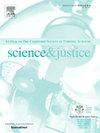An evaluation of the effect of powders on fingermarks developed with cyanoacrylate fuming
IF 1.9
4区 医学
Q2 MEDICINE, LEGAL
引用次数: 0
Abstract
The use of cyanoacrylate (CA) fuming for the detection of fingermarks is generally followed by a secondary process such as dye staining or powdering. This study presents Phase 2 trials with planted fingermarks across five enhancement sequences comparing the use of basic yellow 40 (BY40) dye staining and a variety of powders (black magnetic powder, Bristol Black and fpNatural® 1 and 2) after CA fuming on two different types of plastic materials. Other variables included 10 fingermark donors, four ageing periods and 50 depletions. These trials were then followed by Phase 3 trials to assess whether the results observed in Phase 2 trials are replicated on similar plastic items typically submitted to forensic laboratories. For Phase 2 trials, the use of BY40 as a secondary process to CA fuming resulted in more high-quality graded marks when compared to powdering. The fingermark grading data from the five enhancement sequences showed a significant difference with a moderate effect size. With the exception of black magnetic powder, the powdering of CA-treated marks resulted in a detrimental effect due to infill of ridge detail. BY40 staining after the use of powders improved some of the detrimental effects; however, the use of BY40 without powders, in general, was more effective. Phase 3 trials yielded a correlation to Phase 2 trials whereby the two-step process of CA fuming with BY40 was the most effective enhancement sequence. It is therefore recommended that BY40 dye staining, rather than powders, is employed as a secondary process to CA fuming, unless the use of BY40 is not possible due to the porosity of the substrate.
粉末对氰基丙烯酸酯熏烟手印效果的评价
使用氰基丙烯酸酯(CA)熏烟法检测手印后,通常要进行二次处理,如染色或粉化。本研究展示了在五个增强序列中植入手印的第二阶段试验,比较了在两种不同类型的塑料材料上CA熏烟后使用碱性黄40 (BY40)染料染色和各种粉末(黑色磁性粉末、Bristol black和fpNatural®1和2)。其他变量包括10个手印供体、4个老化周期和50个耗竭。这些试验之后是第三阶段试验,以评估在第二阶段试验中观察到的结果是否可以在通常提交给法医实验室的类似塑料物品上复制。在第二阶段的试验中,与粉末相比,使用BY40作为CA烟熏的二次工艺产生了更高质量的分级标记。5个增强序列的手印分级数据差异显著,效应量中等。除黑色磁粉外,ca处理标记的粉化由于脊状细节的填充而产生不利影响。使用BY40染色后的粉末改善了一些有害影响;然而,一般来说,使用不含粉末的BY40更有效。第3期试验与第2期试验产生了相关性,其中用BY40进行CA熏烟的两步过程是最有效的增强序列。因此,建议使用BY40染料染色,而不是粉末,作为CA烟熏的二次工艺,除非由于基材的孔隙性而不可能使用BY40。
本文章由计算机程序翻译,如有差异,请以英文原文为准。
求助全文
约1分钟内获得全文
求助全文
来源期刊

Science & Justice
医学-病理学
CiteScore
4.20
自引率
15.80%
发文量
98
审稿时长
81 days
期刊介绍:
Science & Justice provides a forum to promote communication and publication of original articles, reviews and correspondence on subjects that spark debates within the Forensic Science Community and the criminal justice sector. The journal provides a medium whereby all aspects of applying science to legal proceedings can be debated and progressed. Science & Justice is published six times a year, and will be of interest primarily to practising forensic scientists and their colleagues in related fields. It is chiefly concerned with the publication of formal scientific papers, in keeping with its international learned status, but will not accept any article describing experimentation on animals which does not meet strict ethical standards.
Promote communication and informed debate within the Forensic Science Community and the criminal justice sector.
To promote the publication of learned and original research findings from all areas of the forensic sciences and by so doing to advance the profession.
To promote the publication of case based material by way of case reviews.
To promote the publication of conference proceedings which are of interest to the forensic science community.
To provide a medium whereby all aspects of applying science to legal proceedings can be debated and progressed.
To appeal to all those with an interest in the forensic sciences.
 求助内容:
求助内容: 应助结果提醒方式:
应助结果提醒方式:


